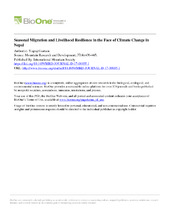| dc.description.abstract | Migration for work remains a livelihood strategy in subsistence farming communities globally, especially in view of unprecedented environmental change. Farmers in the high Himalaya migrate during the winter, when farming activities are reduced. This study examined the drivers of seasonal migration in the context of climate change and migration's role in food security and livelihood resilience in the district of Humla, Nepal. Focus group discussions and a household socioeconomic survey were conducted. The results suggest that rather than climate change impacts, structural poverty is the root cause of migration, such that men from poor households with small landholdings and high food insecurity, mainly belonging to low-caste groups, migrate for work during the winter. Focus group participants also presented a clear perception of climate variability and change and their negative impacts on crop production. In this context, the poorest households find cultivating their own land risky. Moreover, the traditional practice of sharecropping, which helped them reduce food shortages, has also become less profitable. Therefore, more households are likely to participate in seasonal migration in the context of climate change, and those already migrating are likely to do so for longer time periods. Currently, such migrants take up low-paying unskilled wage work, mainly in towns and cities in Uttarakhand, India, which enable them to make only modest savings, hardly enough to repay the debt their family has incurred during food shortages. Even in the future, these farmers are likely to be limited to the same migration pattern, because they lack the social ties, education, and financial capital needed to fulfill the administrative and monetary requirements for more economically promising long-term overseas migration. Thus, it is unlikely that migration will make a significant contribution to building livelihood resilience in the context of climate change in remote Himalayan farming communities. | en_US |

